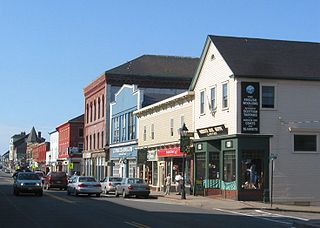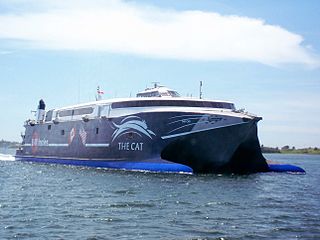
Yarmouth is a town in southwestern Nova Scotia, Canada. A port town, its industries include fishing and tourism. It is the terminus of a ferry service to Bar Harbor, Maine, run by Bay Ferries.
USS Puerto Rico may refer to:

Bay Ferries Limited, or simply, Bay Ferries, is a ferry company operating in eastern Canada and is headquartered in Charlottetown, Prince Edward Island, Canada. It is a subsidiary of Northumberland Ferries Limited and a sister company to the defunct Bay Ferries Great Lakes Limited.

Scotia Prince Cruises was a cruise ferry operator based in Maine which owned and operated the M/S Scotia Prince. This ferry operated across the Gulf of Maine between Portland, Maine, and Yarmouth, Nova Scotia, until the end of the 2004 sailing season.

Sea Fighter (FSF-1) is an experimental littoral combat ship in service with the United States Navy. Its hull is of a small-waterplane-area twin-hull (SWATH) design, provides exceptional stability, even on rough seas. The ship can operate in both blue and littoral waters. For power, it can use either its dual gas-turbine engines for speed or its dual diesel engines for efficient cruising. It can be easily reconfigured through the use of interchangeable mission modules. Helicopters can land and launch on its deck. Smaller water craft can be carried and launched from its stern. The vessel is being developed under the program title Littoral Surface Craft-Experimental with a hull type designation Fast Sea Frame. The first vessel has been assigned the hull classification symbol FSF 1 and also has been referred to as the X-Craft. The vessel was designed by British company BMT Nigel Gee who continue with a role in the development of the vessel.

The Port of Portland is a seaport located in Portland, Maine. It is the second-largest tonnage seaport in New England as well as one of the largest oil ports on the East Coast. It is the primary American port of call for Icelandic shipping company Eimskip.

Austal USA is an American shipbuilder based on Blakeley Island in Mobile, Alabama. It is a subsidiary of the Australian shipbuilder Austal, operating under a Special Security Arrangement which allows it to work independently and separately on some of the most sensitive United States defense programs despite its foreign ownership.

A high-speed craft (HSC) is a high-speed water vessel for civilian use, also called a fastcraft or fast ferry. The first high-speed craft were often hydrofoils or hovercraft, but in the 1990s catamaran and monohull designs become more popular. Most high-speed craft serve as passenger ferries, but the largest catamarans and monohulls also carry cars, buses, large trucks and freight.

TheHSC Hai Xia Hao is a passenger / vehicle ferry. It is a high speed catamaran built by the Tasmanian shipbuilder Incat.
Hawaii Superferry was a Hawaii-based transportation company that provided passenger and vehicle transportation between Honolulu Harbor on the island of Oʻahu and Kahului Harbor on Maui. Legal issues over environmental impact statements and protests from residents of Maui and Kauaʻi temporarily delayed the implementation of service, but service between Oʻahu and Maui began in December 2007. The company had hoped to return service to Nawiliwili Harbor on Kauaʻi and additionally planned to eventually provide service to Kawaihae Harbor on the Big Island.

Dublin Swift is a high-speed catamaran built in 2001 by Austal as a passenger and vehicle catamaran ferry. After conversion to a Maritime Prepositioning ship the vessel was chartered by the United States Navy's Military Sealift Command until January 2018 as WestPac Express. It was then converted for civilian use as a passenger ferry by Irish Ferries and renamed Dublin Swift.

The HSC Virgen de Coromoto is an 86 m (282 ft) fast catamaran ferry operated by Consolidada de Ferrys C.A. in Venezuela. It was built in Australia in 2004 for a fast ferry service on Lake Ontario between Toronto, Ontario, Canada and Rochester, New York, United States. After the ferry service failed, the boat was sold in 2007 and operated in the Strait of Gibraltar on a Spain-Morocco service until 2012. In 2012–13, the ship operated on Kattegatruten's Aarhus–Kalundborg route in Denmark until October 2013 when the route was cancelled.

Austal Limited is an Australian-based global ship building company and defence prime contractor that specialises in the design, construction and support of defence and commercial vessels. Austal's product range includes naval vessels, high-speed ferries, and supply or crew transfer vessels for offshore windfarms and oil and gas platforms.
The transportation system of Hawaii is a cooperation of complex systems of infrastructure.

USNS Guam (T-HST-1), formerly Hawaii Superferry's Huakai, is a United States Navy high-speed transport vessel. The ship was completed in September 2008 and was intended to start Hawaiian service in May 2009, though delivery postponements saw that planned service canceled. In the Hawaiian language, huakaʻi means "journey".

The Spearhead-class expeditionary fast transport (EPF) is a United States Navy–led shipbuilding program to provide a high-speed, shallow draft vessel intended for rapid intra-theater transport of medium-sized cargo payloads. The EPFs can reach speeds of 35–45 knots, and allow the rapid transit and deployment of conventional or special forces, equipment and supplies.

USNS Fall River (JHSV-4/T-EPF-4) is the fourth Spearhead-class expeditionary fast transport, which is operated by the United States Navy's Military Sealift Command (MSC). Fall River was built by Austal USA in Mobile, Alabama.

USNS Spearhead (JHSV-1/T-EPF-1) is the lead ship of the Spearhead-class expeditionary fast transport to be operated by the United States Navy's Military Sealift Command. USNS Spearhead was christened on 17 September 2011.

USNS Millinocket (JHSV-3/T-EPF-3)(ex-Fortitude) is the third Spearhead-class expeditionary fast transport, which is operated by the United States Navy's Military Sealift Command and was built in Mobile, Alabama.

USNS Puerto Rico (T-EPF-11) is the eleventh Spearhead-class expeditionary fast transport and currently in service with the United States Navy's Military Sealift Command.

















